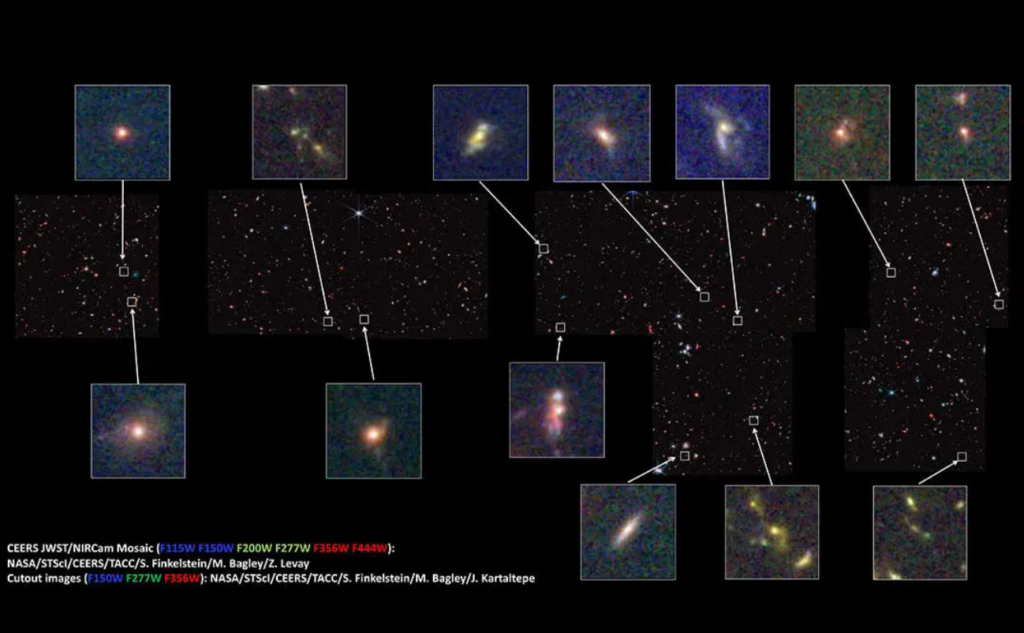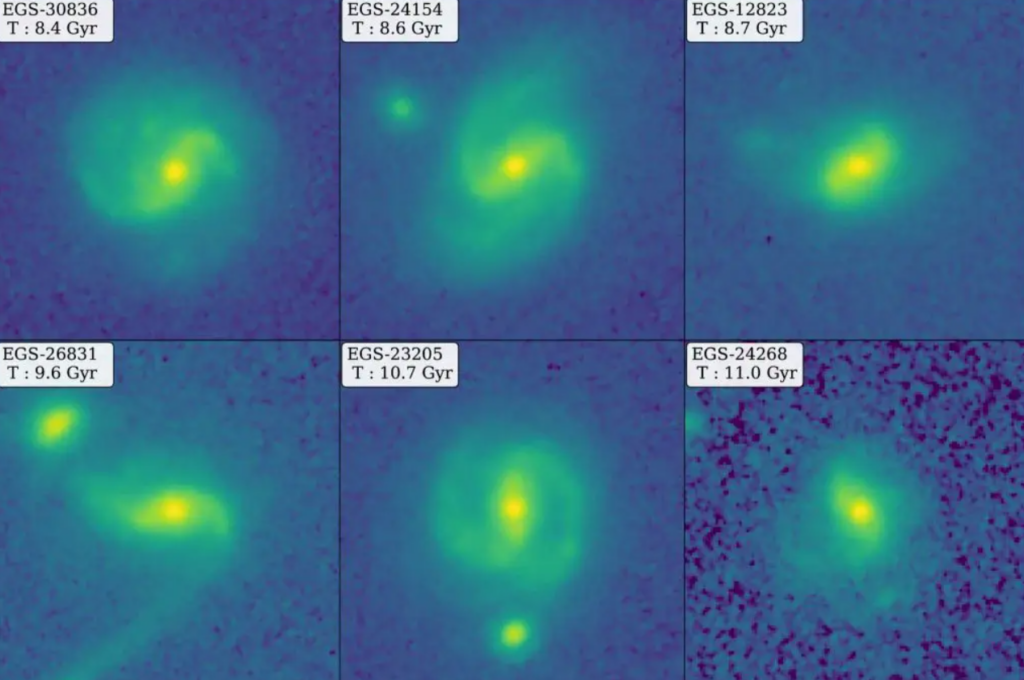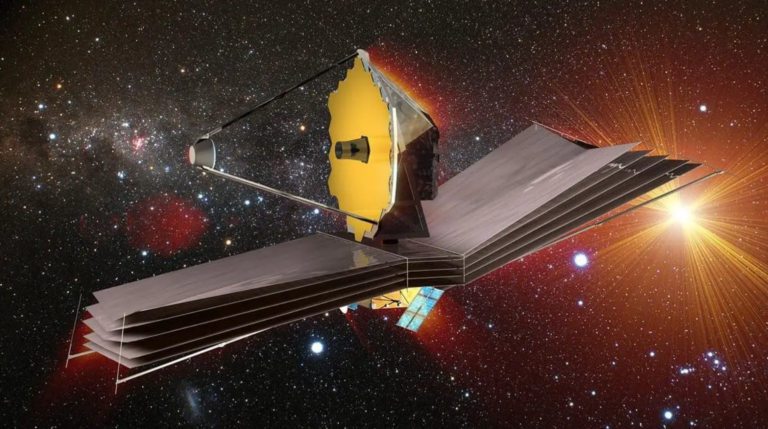The James Webb telescope has detected a multitude of ancient galaxies that appear to be more developed than initially thought.
The James Webb Space Telescope has uncovered a groundbreaking revelation as it observes the vast expanse of the sky filled with distant galaxies. Research teams have found that the earliest galactic communities seem to be more advanced and abundant than previously believed. This discovery has the power to revolutionize our comprehension of the processes involved in the birth of the initial galaxies.

Jeyhan Kartaltepe, a contributor to the Cosmic Evolution Early Release Science (CEERS) collaboration, has provided valuable insights into the observations made by the Webb telescope regarding galaxies dating back to a time when the universe was between 500 million and 2 billion years old.
Previous studies, including those conducted using the Hubble Space Telescope, have indicated that as we look further back into the universe’s history, the organized and rotating disks seen in modern galaxies give way to more chaotic configurations, suggesting the turbulent mergers that formed the earliest galaxies. However, classifying the most distant galaxies has been a challenge, as they often appear as faint smudges. This is where the Webb telescope proves its worth.
With its ability to detect longer wavelengths, the Webb telescope can peer even further back in time. Furthermore, its images offer greater clarity and sensitivity compared to those captured by the Hubble telescope. Leveraging these advancements, the CEERS team has identified 850 early galaxies, determined their distances, and categorized their shapes as either “disk,” “spheroid,” or “irregular.”
It is important to note that these classifications are not rigidly defined. Galaxies are complex and cannot be easily categorized. As Kartaltepe explains, some galaxies exhibit characteristics of both a disk and a central bulge, similar to our own Milky Way.
While future classification efforts may rely more on computational methods, such as convolutional neural networks, the current task of classifying these galaxies remains primarily in the hands of human researchers. Three members of the CEERS team meticulously examined each of the 850 galaxies to assign their classifications.
Remarkably, despite their young age, these galaxies bear similarities to those closer to us. The prevalence of disk galaxies in the early universe has only slightly decreased, while the proportions of galaxies with a central bulge and those with irregular shapes have remained relatively stable over cosmic epochs.
Kartaltepe notes that finding disk galaxies in the early universe, where conditions for disk formation were thought to be rare, is like coming across teenagers instead of toddlers. She explains that while the presence of disk galaxies is not unexpected, their sheer number is what is truly remarkable. According to her, we have not yet observed the initial phases of galaxy formation.
Version 1: Kartaltepe points out the discovery of disk galaxies in the early universe, where conditions for disk formation were believed to be scarce, is comparable to encountering teenagers instead of toddlers. She emphasizes that while the existence of disk galaxies is not surprising, their abundance is what is truly astonishing. She also mentions that the nascent stages of galaxy formation are yet to be witnessed.

However, Kartaltepe highlights that these early disks exhibit distinct characteristics compared to their contemporary counterparts. She emphasizes that they do not resemble the present-day Milky Way, as they are characterized by turbulence, disorder, and therefore require additional scrutiny.
AN EXCESS OF DISTANT GALAXIES
During the AAS press conference, Haojing Yan from the University of Missouri presented new findings on galaxies from an even earlier period in cosmic history. By utilizing Webb’s multi-wavelength images, Yan was able to identify 87 distant galaxies located behind the galaxy cluster SMACS 0723. These galaxies were observed to have their light magnified and distorted by the gravitational lensing effect of the cluster. Based on estimates, these galaxies are believed to have originated between 200 million and 400 million years after the Big Bang, which corresponds to a redshift as high as 20.
While these findings await spectroscopic confirmation, preliminary estimates indicate that the majority of previously confirmed distances align with spectroscopic data. Even if only half of Yan’s selection is ultimately confirmed as genuinely distant galaxies, the sheer number would still surpass expectations. This challenges our prior understanding of galaxy formation in the early universe, as stated by Yan.
Addressing this perplexing situation is theorist Jordan Mirocha from the Jet Propulsion Laboratory, who presented later during the conference. Mirocha suggests that there are two possibilities: either there is an abundance of galaxies or they are significantly brighter than what our conventional models predict. He argues that various interconnected factors are at play, disrupting our predictive models.
The earliest galaxies emerged within expanding dark matter halos, with ordinary hydrogen gas being gravitationally drawn towards accumulating dark matter particles. Mirocha proposes that this influx of matter may have hindered the stellar feedback mechanisms that regulate star formation in contemporary galaxies. While the rapid formation of new stars would give early galaxies their luminosity, it would also generate dust, obscuring their brilliance.
Finding a way to reconcile these different factors is crucial in understanding the origins of the first galaxies. Mirocha acknowledges the challenge, stating, “I believe we have much to ponder.”
Do not forget to share your opinion with us to provide you with the best posts !




0 Comments